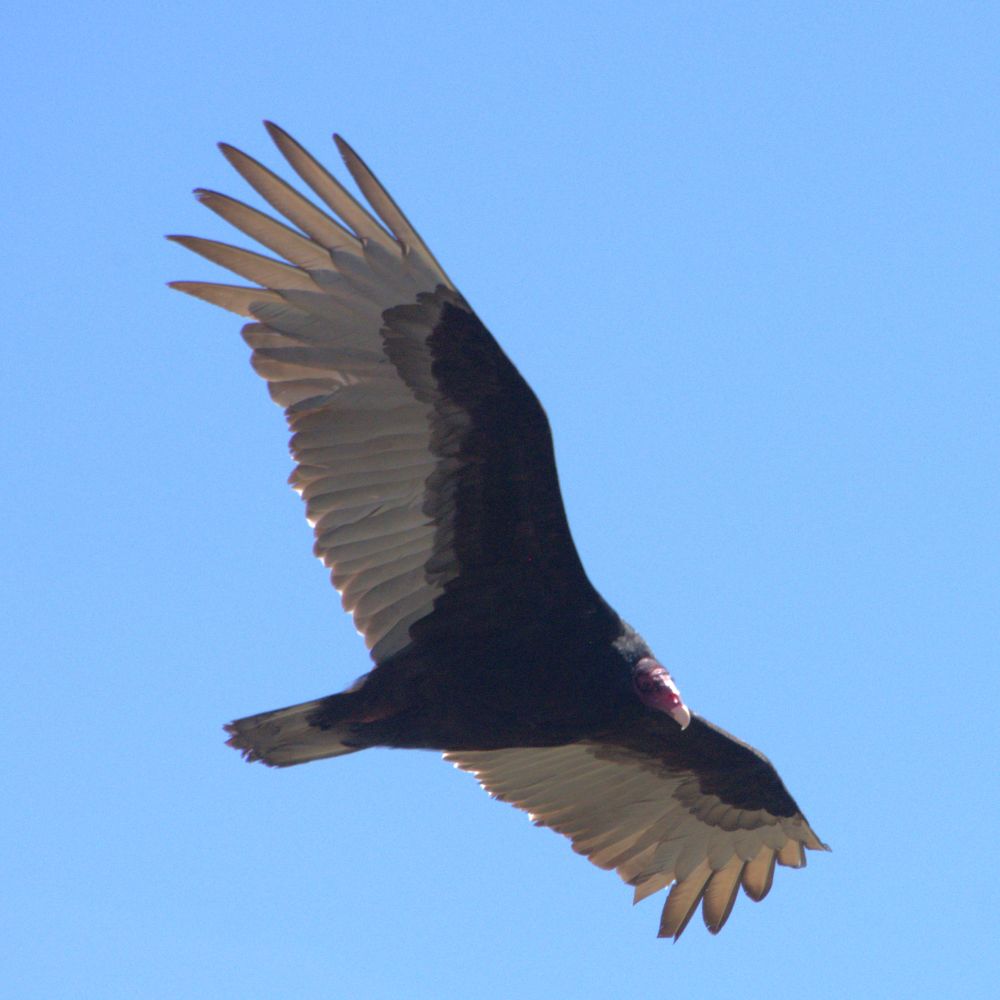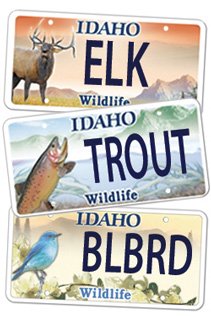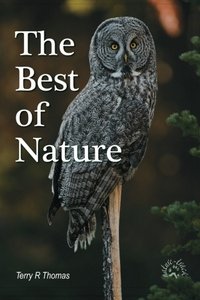Benefits of Flight

Copyright TerryRThomas/nature-track.com
With its huge broad wings, a turkey vulture can soar up to seven miles without a wingbeat.
Last week I was on top of a butte in Island Park, high enough that the vultures were often below me. They displayed their incredible flying skills as they circled on the thermals, rising and falling and rising again with hardly a wingbeat. Several times I watched them glide for over a mile without a single wing stroke and change altitude quickly by pointing wings back or even tucking them to the body for a second or two.
Flight in the animal world is the realm of birds, bats, and insects (and at one time, reptiles). Each group independently resolved issues with flight millions of years ago. These issues included, how to get body weight low enough and how to shape a wing so that lift could occur. Since then, flight has allowed these select groups to do some incredible things.
In one sense, there are three things that flight accomplishes for birds, bats, and insects: altitude, speed, and agility. High flying birds are a common phenomenon. The Ruppel’s vulture holds the record with a flight of 37,100 feet documented in 1973 when one collided with a high-flying jet over the Ivory Coast at that altitude. However, other species, notably the bar-headed goose and the common crane, make migrations over the top of the Himalaya Mountains, the tallest in the world (this is where Mount Everest is at 29,031 feet asl). These birds fly as high as 27,000 and 33,000 feet respectively to clear the mountains. Why, we might ask, do they do that? Surely that must be a tremendous energy expense.
There are two good reasons why these birds choose high flying. Eagles hunt them during migration and flying high reduces predation risk. Also, at these altitudes they, like jetliners, can take advantage of jet streams to reduce travel time.
On our side of the pond, high fliers include the snow goose, mallard duck, and turkey vulture, all recorded as high as 20,000 feet. The Swainson’s hawk and bald and golden eagles have been recorded flying as high as 10,000 feet above ground.
Speed is yet another advantage of flight. Believe it or not, recent testing has shown that the Brazilian free-tailed bat is faster than any bird with a top speed in level flight of 105 mph. Peregrines, acknowledged as the fastest animal on the planet, can attain speeds of around 190 mph, but that is in a stoop or dive, not level flight. At one time the fastest bird was considered to be the common swift at around 68 mph. Better scientific equipment has shown though that several birds can exceed 80 or even 90 mph.
The challenge with measuring speed is wrapped around conditions. Since flight is three-dimensional, a slight down angle can give a bird a decided burst of speed as can the proper wind conditions and even temperature. So, in my mind, any speed records posted for a particular bird, for instance the red-breasted merganser with a top reported speed of 97 mph, must be taken with a little salt. It will likely be impossible to test every bird under exactly the same conditions, so speed will remain a bit arbitrary.
Agility is another benefit of flight. Watching swallows or bats capture mosquitoes on the wing is amazing. However, hummingbird agility is unsurpassed, perhaps in all the animal kingdom. Human machines cannot even come close to what a hummingbird can do and at speeds as high as 51 mph (385 body lengths per second. For a six-foot human, that would be 2,310 feet per second). They can go straight up or down, backward, forward, or combinations thereof, hover, and make near 90 degree turns at speed.
One final benefit of flight for some species is the ability to turn the air into their habitat. For instance, a magnificent frigate bird, a seabird, uses an astounding eight-foot wingspan to keep a three-and-a-half-pound body (the largest wingspan to body weight ratio of any other bird species in the world) aloft for up to 200 days without landing. This allows them to forage far out into the oceans where they otherwise could not roam. The common swift though, has been documented continuously flying for up to ten months at a stretch.
What about sleep for these birds? Both have the remarkable ability to sleep while flying. They use unihemispheric slow-wave sleep where they can switch off one hemisphere of their brain at a time, essentially allowing half of their brain to sleep while the other half remains awake to control flight. Frigate birds also can sleep in 10-second bursts while riding a thermal upward.
Flight. With all the benefits, I wish I could do it, but I would not want to give up my nap time.
Help Idaho Wildlife
When we traveled across the state in October 2017, we visited most of the Idaho Department of Fish and Game wildlife management areas. Most of the vehicles we saw using the wildlife management areas did not have wildlife plates. Buying wildlife plates is a great way for non-hunters and hunters alike to support wildlife-based recreation like birding.
C'mon folks, let's help Idaho's wildlife by proudly buying and displaying a wildlife license plate on each of our vehicles!
See below for information on Idaho plates. Most states have wildlife plates so if you live outside Idaho, check with your state's wildlife department or vehicle licensing division for availability of state wildlife plates where you live.
And tell them that you heard about it from Nature-track.com!

Wildlife License Plates
Great news! as of 2024, there are three NEW designs for license plates. They still are bluebird, cutthroat trout and elk, but they are beautiful.
Idaho Wildlife license plates provide essential funding that benefits the great diversity of native plants and wildlife that are not hunted, fished or trapped—over 10,000 species or 98% of Idaho’s species diversity. Game species that share the same habitats (such as elk, deer, antelope, sage-grouse, salmon, trout) also benefit from these specialty plates.
No state tax dollars are provided for wildlife diversity, conservation education and recreation programs. Neither are any revenues from the sale of hunting or fishing licenses spent on nongame species. Instead, these species depend on direct donations, federal grants, fundraising initiatives—and the Idaho Wildlife license plates.
Both my vehicles have Bluebird Plates. I prefer the bluebird because the nongame program gets 70 percent of the money from bluebird plates, but only 60 percent of the money from elk and trout plates - 10 percent of the money from elk plates supports wildlife disease monitoring and testing programs (to benefit the livestock industry) and 10 percent from cutthroat plates supports non-motorized boat access.
Incidentally, in 2014, the Idaho Legislature denied the Department of Fish and Game the ability to add new plates or even to change the name of the elk and cutthroat plates (very specific) to wildlife and fish plates, a move that would have allowed for changing images occasionally and generating more revenue. It would seem that they believe that we Idahoans don't want a well funded wildlife program.
I think it is time we let the Legislature know that Idahoan support wildlife funding and that we would like to see these generic plates come to fruition.

"WOW. What a phenomenal piece you wrote. You are amazing." Jennifer Jackson
That is embarrassing, but actually a fairly typical response to my nature essays. Since The Best of Nature is created from the very best of 16 years of these nature essays published weekly in the Idaho Falls Post Register (online readership 70,000), it is a fine read. It covers a wide variety of topics including humorous glimpses of nature, philosophy, natural history, and conservation. Readers praise the style, breadth of subject matter and my ability to communicate complex and emotional topics in a relaxed and understandable manner.
Everyone can find something to love in this book. From teenagers to octogenarians, from the coffee shop to the school room, these nature essays are widely read and enjoyed.
Some of the essays here are my personal favorites, others seemed to strike a chord with readers. Most have an important message or lesson that will resonate with you. They are written with a goal to simultaneously entertain and educate about the wonderful workings of nature. Some will make you laugh out loud and others will bring a tear to the eye and warm your heart.
Readers Write:
"You hit a home run with your article on, Big Questions in Nature. It should be required reading for everyone who has lost touch with nature...great job!" Joe Chapman
"We enjoyed your column, Bloom Where Planted. Some of the best writing yet. The Post Register is fortunate to have your weekly columns." Lou Griffin.
To read more and to order a copy, click here or get the Kindle version
Copies are also available at:
Post Register
Island Park Builders Supply (upstairs)
Barnes and Noble in Idaho Falls
Harriman State Park, Island Park
Museum of Idaho
Valley Books, Jackson Wyoming
Avocet Corner Bookstore, Bear River National Wildlife Refuge, Brigham City, Utah
Craters of the Moon National Monument Bookstore, Arco, Idaho